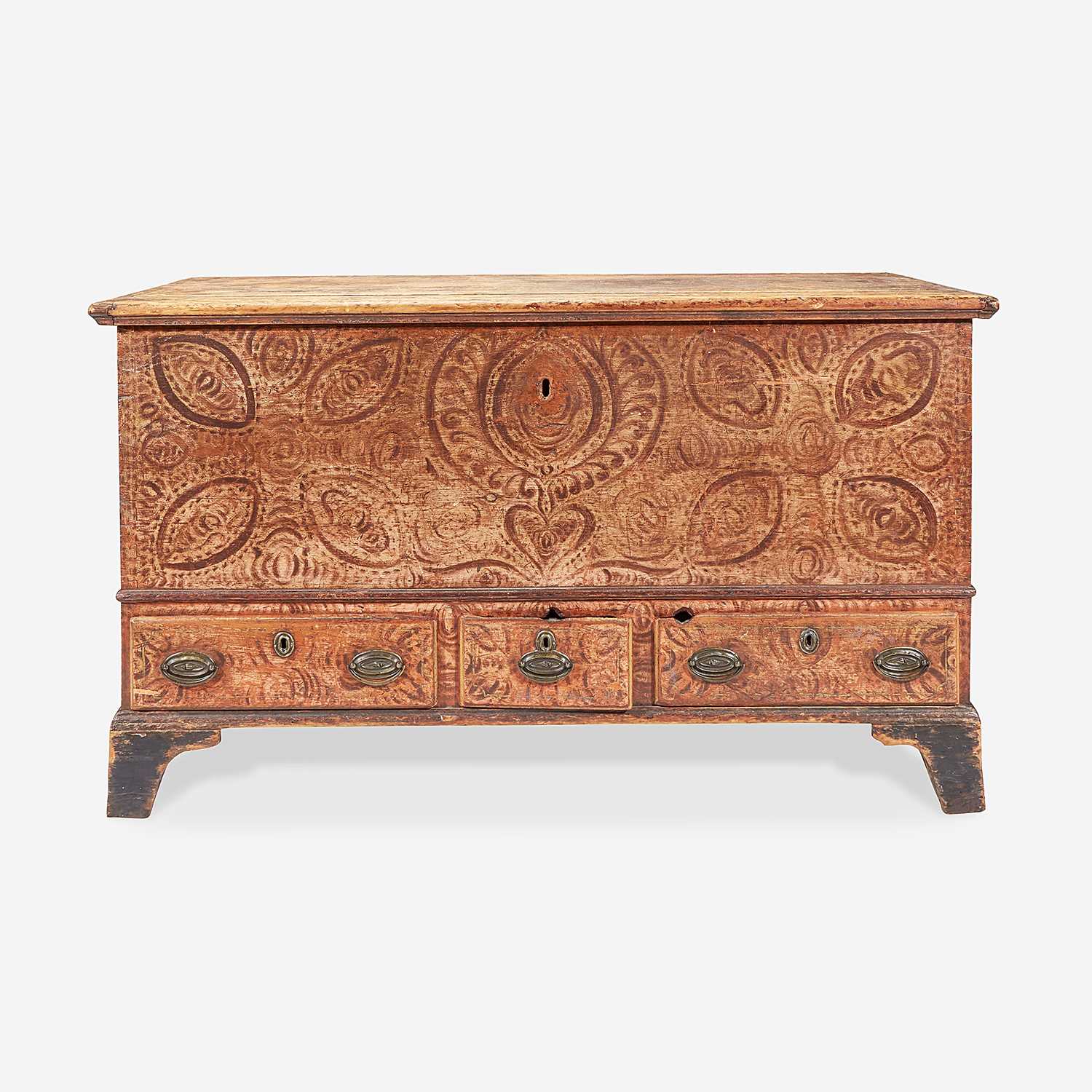How Did Philadelphia Become the Workshop of the World?
The History of American Craft
Freeman's looks back on Philadelphia's history of creative innovation and production.
04/22/2021 News and Film, American Furniture, Folk and Decorative Arts
What is it about southern Pennsylvania that drew—and continues to draw—masterful furniture makers, designers, and woodworkers to settle and create here? From Philadelphia’s founding in 1682, to the heyday of industry and manufacturing in the city in the 19th century, when Philadelphia was dubbed the “workshop of the world,” through to today, the region has been a hotbed of not just industrial, but also artisanal, creation.
The role of immigration was significant to the development of Pennsylvania's distinct creative tradition. The influx of styles and talents brought to the region by immigrants can be found in the earliest Commonwealth-made objects. Founder William Penn welcomed those who sought religious tolerance and personal freedom. Immigrant farmers and laborers populated and cultivated the Commonwealth's vast, fertile land and harvested natural resources, while skilled immigrant craftsmen were welcomed to make the fashionable decorative goods for the striving city of Philadelphia.
Freeman’s American Furniture, Folk and Decorative Arts auction features a number of examples of formal Philadelphia furniture—tables, desks, chests, and clocks in the rococo or Chippendale style from the middle to the end of the 18th century. Philadelphia—the largest, wealthiest and most sophisticated colonial city of the time—attracted a wave of highly skilled immigrant woodworkers and London-trained carvers. These artisans created the finest and most extraordinary examples of American Chippendale furniture. With the prominent use of woods like walnut and mahogany, the ornamental carving and quality of Philadelphia Chippendale furniture surpasses that of all other colonial cities.
Lot 55 | A Chippendale carved mahogany tilt-top tea table, $3,000-5,000
One such piece, a Chippendale carved mahogany tilt-top tea table, provides a fine case study of the period, from its date of construction (ca. 1770) and use of material to its dignified yet understated curves, flourishes, and ball-and-claw feet.
Walnut, chestnut, and cedar are all fundamental to Philadelphia’s preferred woods—both as monikers of major east-west streets, and as the foundation of so much of the city’s furniture production. These readily available native hardwoods were frequently used by early constructors of Chippendale and Queen Anne pieces, but Philadelphia’s positioning as a major port city also allowed for fairly easy shipment of non-native imports like mahogany and rosewood. Small decorative items featured in American Furniture, Folk and Decorative Arts—such as the three-inch-wide patch box made from William Penn’s “Treaty Elm”—underscore the significance of wood selection and provenance. The box is constructed from a historically significant elm tree; its inset inscription announces, “This Box was made from a part of the celebrated Elm tree under the shade of which William Penn the Founder of Pennsylvania made a Treaty with the Indians in the year 1682.”
Philadelphia’s port and prominent status as an international “workshop” resulted in the mixing of cultures and traditions as well as material sources; furniture-makers from a number of ethnic and cultural backgrounds commingled in the city’s woodworking studios. Still, studio production tended to assemble around a coherent aesthetic style—such as the one laid out in Thomas Chippendale’s 1754 The Gentleman and Cabinet-Maker’s Director. As one drifted farther north and west away from the center of Philadelphia, however, one was bound to find more regionally specific furniture-making methods and styles, each with their own defining characteristics.
In the direction of Lancaster and Harrisburg, for instance, Pennsylvania German styles of woodworking and ornamentation dominated 18th and 19th-century interiors. Immigrants from various parts of Continental Europe brought vernacular forms and design traditions to Pennsylvania. Examples in our current sale of American Furniture, Folk and Decorative Arts—including a painted and incised wall box and a painted and decorated wood box—exemplify one common aspect of this style: the use of paint.

Lot 49 | A Chippendale painted and decorated blanket chest, $3,000-5,000
Pennsylvania German furniture-makers often painted directly on the surface of wood, decorating their creations with bright, colorful patterns and motifs, and sometimes entire pastoral scenes. A Chippendale painted and decorated blanket chest, originating in Lehigh County and dated 1781, is a stately piece adorned with carnations, birds, and fish on all sides, while a painted and decorated blanket chest, constructed in Berks County circa 1800, features a continuous, allover decorative pattern that extends even to the chest’s drawers. The use of paint allowed makers to express their individual artistic styles while working within recognizable modes and lineages of furniture-making.

Lot 228 | A painted and decorated blanket chest, $3,000-5,000
Whether working in urban or rural settings, Pennsylvania-based furniture makers have long gathered inspiration from the beauty of the natural environment and the varied wood material native to the area. Centuries later, the legendary American craft furniture maker George Nakashima, who was based out of New Hope, wrote in his 1987 book The Soul of a Tree of “placing stone upon stone, seeking kinship with each piece of wood, eventually creating an inward mood of space, then bit by bit finding peace and joy in the shaping of timber into objects of utility and perhaps, when nature smiles, beauty.” Master 20th century craftsmen like Nakashima and Wharton Esherick both sought inspiration and innovation in the natural environment of Pennsylvania, a tradition forged in the earliest 18th-century furniture-making workshops of Philadelphia that remains strong to this day.
Browse the upcoming auction and register to bid on the items in this collection, or join us online to watch the auction live on April 27.
VIEW THE AUCTION
Have something similar? Get in touch with our American Furniture, Folk & Decorative Art department to request a complimentary auction estimate.
